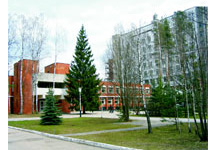William Potter
December 1, 2010
Material Details

Sosny Facility,
Source: http://sosny.bas-net.by
The Obama administration scored a major success today when Belarus announced its plan to eliminate its remaining stocks of highly enriched uranium (HEU) prior to the 2012 Nuclear Security Summit in Seoul, Korea. Belarus is believed to have over 170 kg (374 pounds) of fresh HEU fuel, of which approximately 40 kg (88 pounds) is enriched as high as 90% U-235.
The fissile material is stored at the Sosny Science and Technology Center outside of Minsk and was provided by the Soviet Union for use in an IRT research reactor, a working model of a mobile nuclear power reactor (PAMIR), two critical assemblies, and a sub-critical assembly. The research reactor has been out of operation since 1989; PAMIR was shut down following the Chernobyl accident, and the critical assemblies are not in operation. However, the Yalina-B (Booster) subcritical assembly uses both 90 percent U-235 enriched metallic fuel, 36 percent U-235 enriched uranium dioxide fuel in its core. There is an effort underway to convert these fuels to a 21 percent, 10 percent U-235 configuration, but this work has not been completed.
The Announcement
The announcement of the decision to return the HEU was made in a joint Belarus-U.S. statement issued after U.S. Secretary of State Hillary Clinton and Foreign Minister of Belarus Sergei Martynov met at the Organization for Security and Co-operation in Europe (OSCE) Summit in Astana on December 1, 2010. The news followed an October 8, 2010 inter-governmental agreement between Belarus and the Russian Federation on the return of HEU fuel from Belarus to Russia and the supply of LEU fuel to Belarus for research purposes. The October agreement was initially believed to apply to the HEU at the PAMIR, but now appears to be applicable to all of the HEU on Belarus territory. It is anticipated that the fresh HEU will be blended down to LEU at the Luch nuclear facility in Podolsk, Russia, while HEU in spent fuel will be sent to the reprocessing plant at Mayak.
The package of inducements offered to Belarus by the United States in return for its readiness to part with HEU is not clear from public statements. However, incentives include Washington’s support for participation by Minsk in the 2012 Nuclear Security Summit and its development of peaceful nuclear energy. In the past, Washington also had considered providing assistance in the location and disposal of “orphan” radioactive sources, as well as an invitation to join a nuclear suppliers group known as the Zangger Committee. Earlier this year, the White House had made an invitation to the 2010 Nuclear Security Summit conditional on a pledge by Belarus to eliminate its HEU, terms that were then unacceptable to Minsk.
The case of Belarus has long been regarded by the Department of Energy as the hardest nut to crack with respect to repatriation of Soviet-supplied HEU. Today’s announcement represents a major accomplishment for the Obama administration and a significant step forward in eliminating inadequately protected global stockpiles of HEU.
